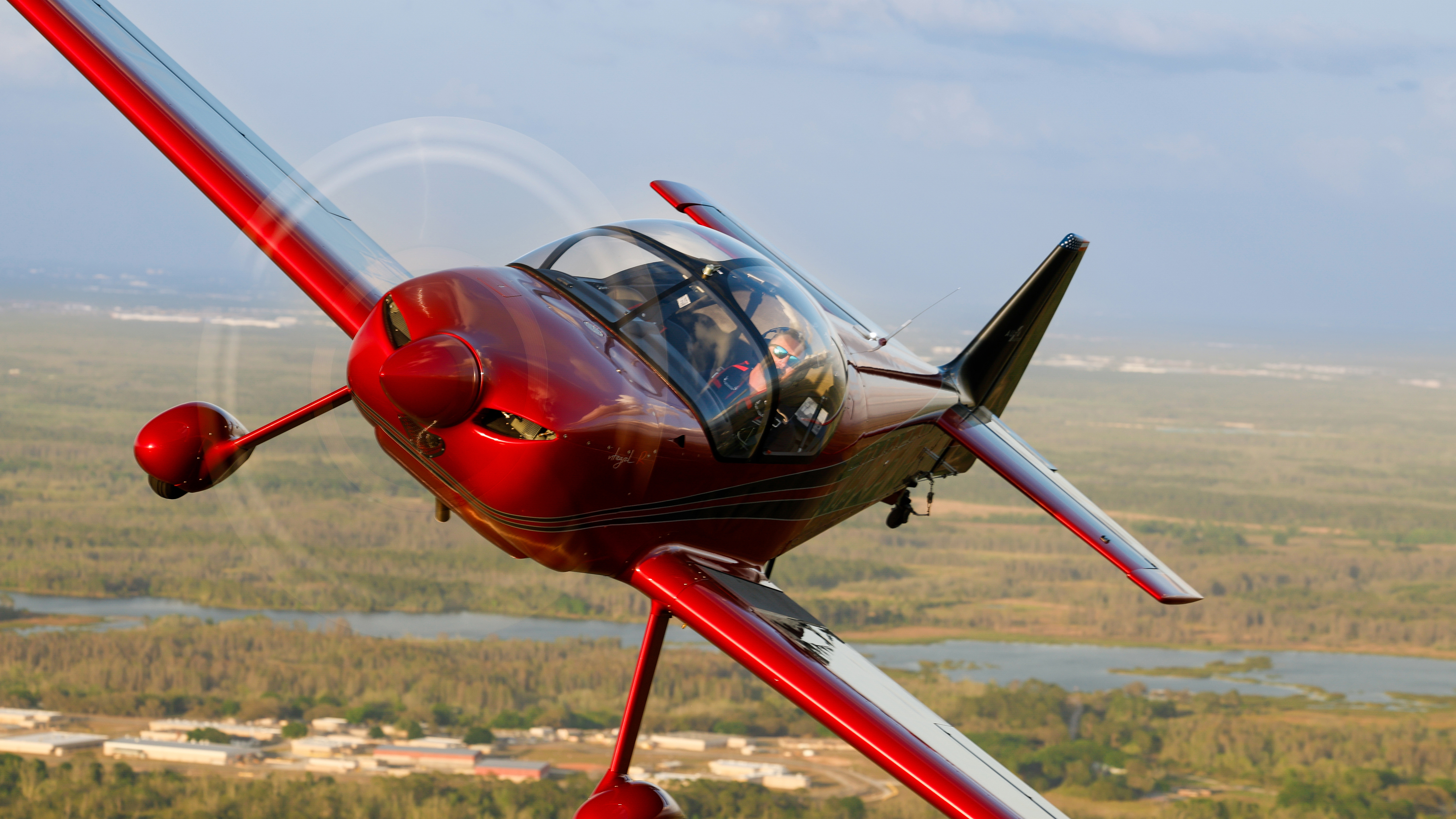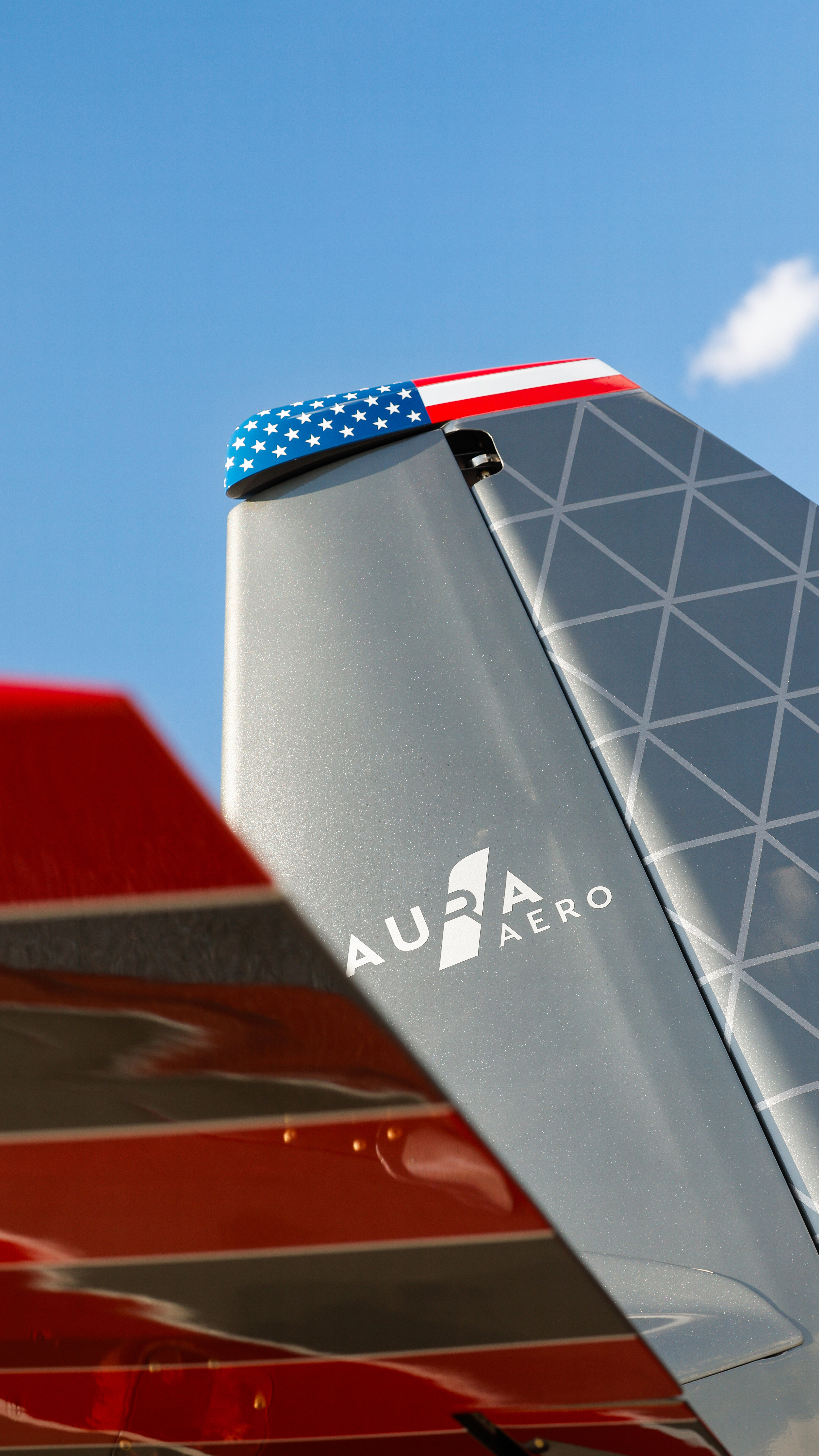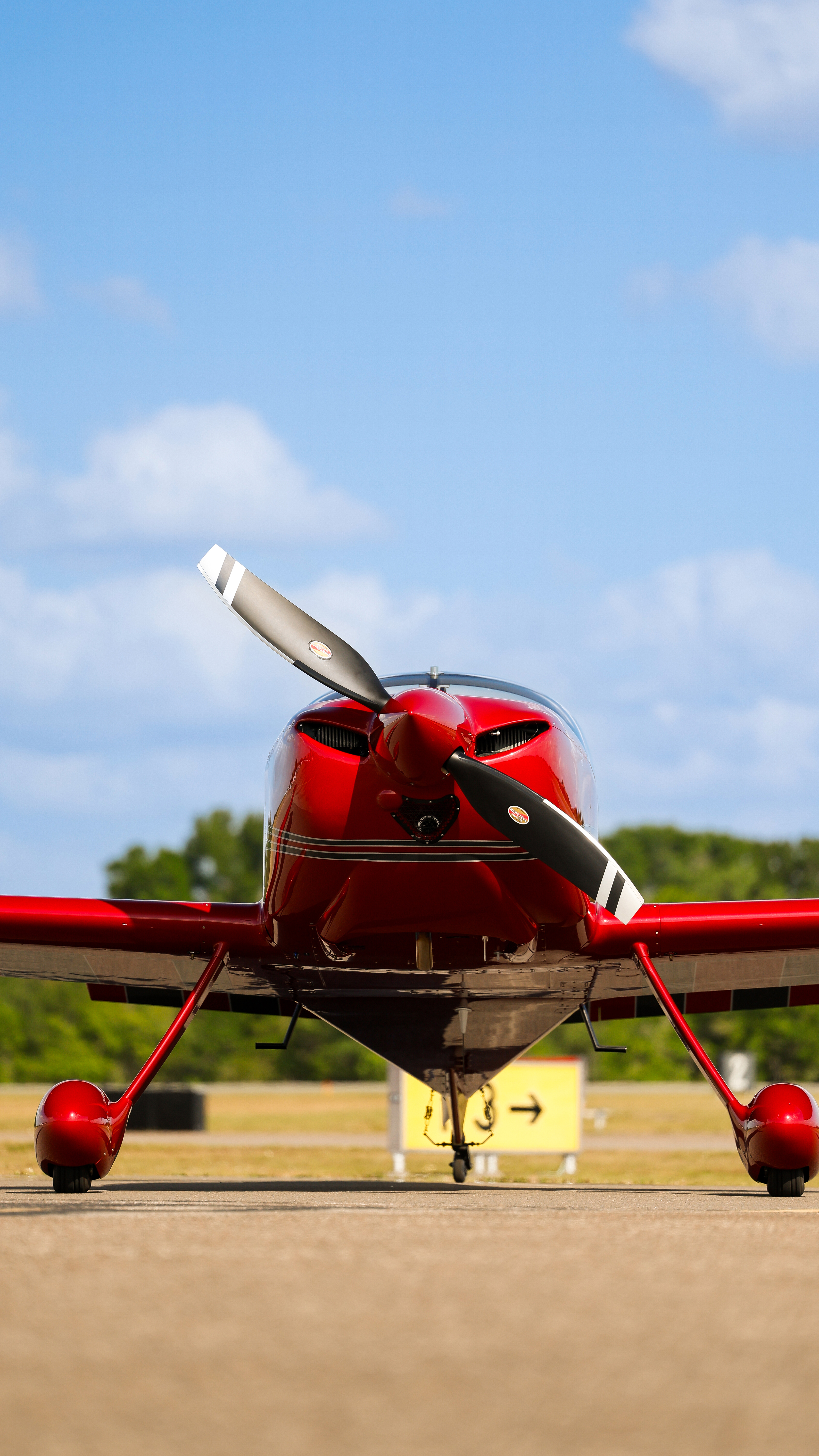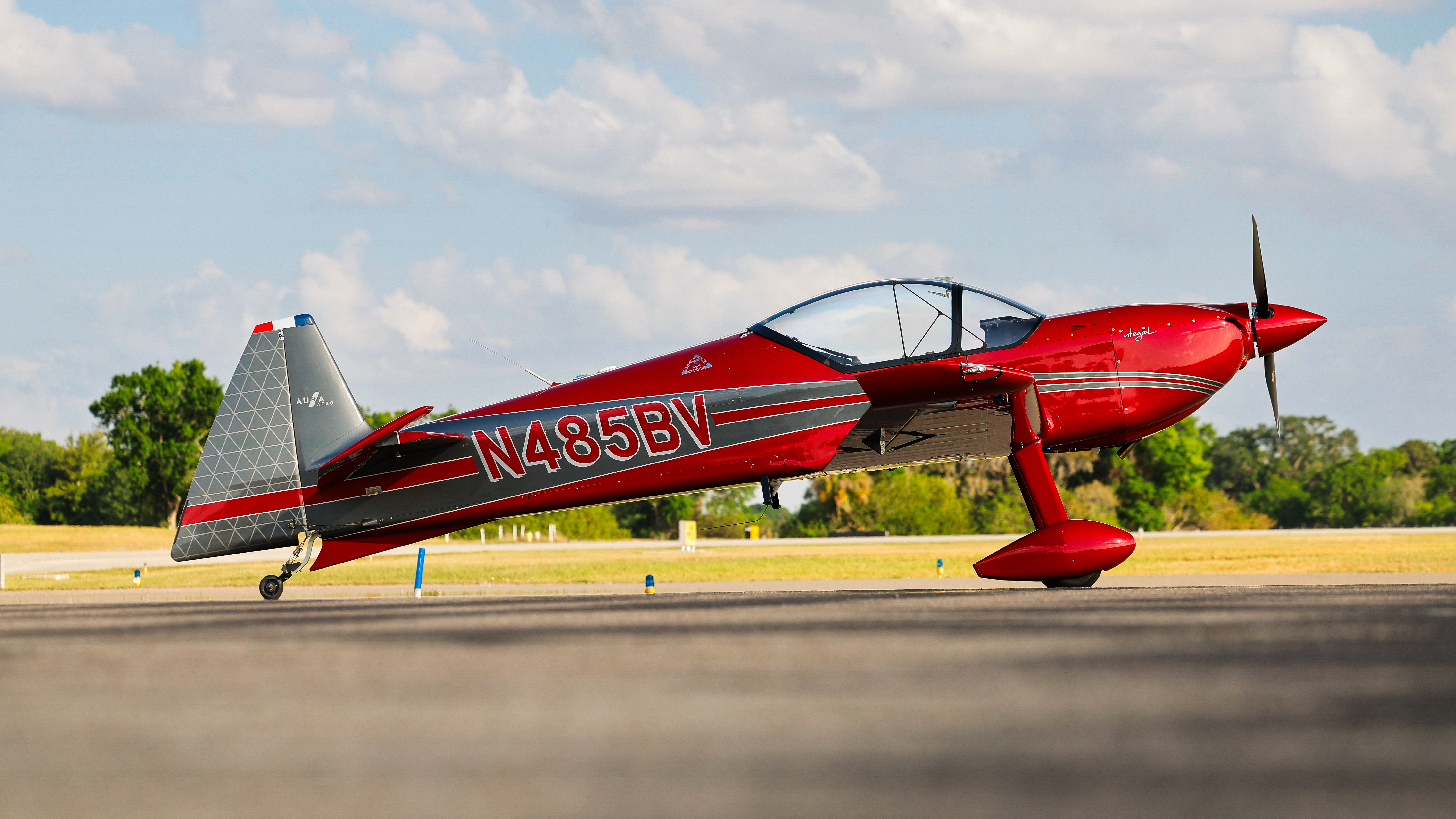It's a stunner
An aerobat with side-by-side seating and a built-in parachute
Positive Gs pull me firmly against the seat as I look left to align the triangular wing tip sighting device with the verdant Wisconsin horizon. The Integral R from Aura Aero settles into a vertical climb, its two-blade, composite propeller clawing through the humid summer sky. “This looks about right,” says Steve Fiegel, a demo pilot and aerobatic instructor at Goulian Aerosports and my guide for this introductory flight.

After 1,300-feet of vertical gain, the Integral runs out of airspeed, and it’s time to kick the left pedal and pivot through a hammerhead turn. The Integral’s oversized rudder performs the turnaround effortlessly, and airspeed increases rapidly in the downline with the 210-horsepower Lycoming AEIO-390 churning at nearly full power. A sustained 4-G pull brings us back to level flight.
This is the first Integral that French manufacturer Aura Aero has sent to the United States, and it’s a stunner. The airplane’s tall stance, side-by-side seating, aft-hinged bubble canopy, and airframe parachute set it apart from other aerobatic trainers. And its 150-plus-knot cruise speed, impressive range and endurance, and digital Garmin avionics make it a versatile traveler, too.
“This is an easy airplane to fly but a hard one to master,” says Fiegel, who has flown the Integral extensively on both aerobatic and cross-country flights since it arrived in the United States. in early 2025. “It fits a wide variety of missions from upset recovery and spin training to aerobatic competition and personal travel.”





Cap 10 inspired
Aura Aero has big plans for the Integral and its diverse family of aircraft. The company is already flying a nosewheel version in France that it will offer as a primary, advanced, and instrument trainer. It’s also working on an electric Integral E, as well as a 19-seat regional airliner that uses electric propulsion and will be built in Florida.
The Integral has a more than passing resemblance to the Mudry CAP 10, a two-seat, aerobatic trainer beloved by the French and widely used in flying clubs there. Consider the Integral an upsized version of the 1970’s classic with modern materials, digital avionics, more power, and greater refinement and durability.
The first thing that jumps out about the Aura is its physical presence. It’s taller and wider than other aerobatic trainers, and it has to be to accommodate its 210-horsepower engine and prop.
The Integral’s symmetrical airfoil is optimized for aerobatics, and its wide ailerons with blunt trailing edges hint at its rapid roll rate of about 200 degrees per second. There are no wing flaps, spades, fences, vortex generators, or other aerodynamic add-ons. Wing fuel tanks hold 12.4 gallons per side, and a fuselage/akro tank holds 19 gallons. The Integral can carry up to 42 gallons of usable fuel on cross-country flights, and the wing tanks must be empty for aerobatics.
The Integral’s main landing gear has a wide wheelbase to tame ground handling, and a steerable tailwheel is mounted on a long leaf spring for shock absorption.
A full-airframe ballistic parachute is embedded in the fuselage. There’s some debate about whether an airframe parachute system absolves Integral pilots and passengers of the requirement to have individual parachutes during aerobatic flights—but Fiegel and I pull on backpack chutes, anyway.
“I’m so used to wearing a parachute that it just doesn’t feel right to fly without one,” he says. “Besides, the regs say ‘wear’ a parachute, so I take that literally.”
The Integral’s tail mirrors CAP aerobatic aircraft in the shape of its rudder and the forward position of the horizontal stabilizer and elevator. The design is meant to aid spin recovery by keeping disturbed air well clear of the rudder. A fixed ventral fin on the bottom of the aft fuselage also enhances yaw stability.
To climb into the Integral, put a foot on the step, grab the recessed handhold, and walk onto the wing root. Then grab a handle atop the glareshield and lower yourself in. The seats adjust fore and aft, as do the rudder pedals, but the seat doesn’t move up or down. Strap in using the Hooker five-point, ratcheting harness.
A Garmin G3X touchscreen primary flight display/multifunction display is located in the center of the panel, and an iPad mount is directly in front of the left-seat pilot along with an analog airspeed indicator and altimeter. Fiegel removes the iPad for aerobatic flights and puts a printed sequence card in its place.
The bubble canopy hinges at the rear and tilts upward. It’s a stylish arrangement, but it also means the canopy must be closed and latched whenever the engine is running—a major drawback in hot climates. Fiegel said the company has developed a mechanism that will allow the canopy to remain partially open for such situations. To close the canopy, simply pull it down, ensure the pins in the side rails are seated properly, and then latch it at the front. It snaps closed with a tight seal.
Engine start is normal for a fuel-injected Lycoming and temperatures and pressures are displayed on the G3X.
I was pleased and relieved to see that the Integral is equipped with two throttle levers, one on the left side of the cockpit and the other in the center. This means the left-seat pilot can fly with a throttle in their left hand and a stick in their right—a highly desirable situation that avoids the unnatural act forcing right-handed pilots to fly lefty.
Taxiing requires a combination of rudder pressure and tapping the hydraulic toe brakes. Forward visibility is excellent on the side the pilot is sitting, but the cross-cockpit view is limited, so exaggerated S-turns are required to clear the area ahead. (A forward-looking video camera with images displayed on the G3X could be helpful here.)
After a standard engine runup on a sweltering afternoon, the takeoff procedure is mercifully short: Line up with the runway centerline, add full engine power, and track straight ahead in a tail-low attitude.



Engine start is normal for a fuel-injected Lycoming and temperatures and pressures are displayed on the G3X.
I was pleased and relieved to see that the Integral is equipped with two throttle levers, one on the left side of the cockpit and the other in the center. This means the left-seat pilot can fly with a throttle in their left hand and a stick in their right—a highly desirable situation that avoids the unnatural act forcing right-handed pilots to fly lefty.
Taxiing requires a combination of rudder pressure and tapping the hydraulic toe brakes. Forward visibility is excellent on the side the pilot is sitting, but the cross-cockpit view is limited, so exaggerated S-turns are required to clear the area ahead. (A forward-looking video camera with images displayed on the G3X could be helpful here.)
After a standard engine runup on a sweltering afternoon, the takeoff procedure is mercifully short: Line up with the runway centerline, add full engine power, and track straight ahead in a tail-low attitude.
Despite a nearly 4,000-foot density altitude, the Integral accelerates with enthusiasm and lifts off after a roughly 10-second, 1,000-foot takeoff roll, then it quickly accelerates to its 90-knot best-rate-of-climb speed as I pitch up to a nearly 15-degree climb. At pattern altitude, I shallow the climb to 10-degrees/110 KIAS for better forward visibility and cylinder cooling. Then I set 2,500 prop rpm and 25 inches of manifold pressure and turn the electric fuel pump off. Tighten the seatbelt harness, confirm the fuel selector is on the akro tank, and it’s time to maneuver. the seat belt harness, confirm the fuel selector is on the akro tank, and it’s time to maneuver.
I set the elevator trim using the switch atop the control stick, then deactivate the electric trim using a switch on the instrument panel. Since the center of pressure on a symmetrical wing doesn’t change with airspeed, the trim pressure remains constant—and disabling the trim switch prevents the pilot from inadvertently moving it during aggressive maneuvers.
Control harmony is delightful. Breakout forces are moderate, and the ailerons are crisp with a light centering tendency. Elevator forces are moderate, too, and consistent. The elevator seems not to get lighter or heavier as airspeed changes. Visibility in flight is good overall, and excellent on the side the pilot is sitting on.
A series of mostly positive-G aerobatic maneuvers inspires immediate confidence. The Integral is energetic and precise yet obedient. From stall speed to deep in the yellow arc on the airspeed indicator, the Integral seems to have no dark corners. It’s all Dr. Jekyll and no Mr. Hyde.
Over-the-top maneuvers such as loops and half-Cubans entered at 160 KIAS or more cover about 1,200 vertical feet from bottom to top. Point rolls start and stop quickly and accurately, and inverted fuel and oil systems allow negative-G without abusing the engine.
We return to the airport where a 7-knot surface wind is almost perfectly aligned with the landing runway. Fiegel advises 90 knots, and I comply during a curving approach to final. Even without wing flaps, putting the prop in flat pitch/high rpm and modulating engine power allows precise speed control.
“You’ll find that 90 knots is a little too fast,” Fiegel warns. “But it gives you plenty of time to flare in ground effect, reduce the power to idle, and find the runway.”
I make a wheel landing, and the airplane tracks straight ahead after touchdown. I’m ready to intervene if the airplane darts one way or the other, but the Integral rolls along without any input from me.







Proven features
 Some trends are clear in new general aviation airplanes, and the most popular changes are bigger engines, wider cabins, carbon fiber everything, airframe parachutes, and tricycle landing gear. Our tribe has spoken, and this is what aircraft owners want and are willing to pay for. Aura Aero has been listening, and the Integral R provides those features.
Some trends are clear in new general aviation airplanes, and the most popular changes are bigger engines, wider cabins, carbon fiber everything, airframe parachutes, and tricycle landing gear. Our tribe has spoken, and this is what aircraft owners want and are willing to pay for. Aura Aero has been listening, and the Integral R provides those features.
The airplane in this report, N485BV, is the third Integral R produced, and its fit and finish is outstanding. Red and gray paint glisten, and the avionics and accessories (Beringer, Hartzell, Lycoming, Hooker, Garmin) are top quality and thoughtfully organized.
The Integral’s closest FAA-certified competitor is the Xtreme Decathlon by American Champion, which uses the same 210-horsepower engine. But the two airplanes’ differences in materials, seating, and an airframe parachute are considerable—and they’ll diverge even more with Integral’s IFR, tricycle-gear version.
French aviation has always been known for its passion, and that shows in the Integral R. Its design and performance are excellent, and flying the airplane is an exhilarating, joyful experience. It can perform some advanced aerobatic figures, and it’ll be a formidable competitor in the sportsman and intermediate competition categories. Yet its real future is likely to be outside the competition aerobatic box. And its most
formidable competitors might not be FAA-certified.
It’s easy to imagine the Integral R—particularly the tricycle-gear version—becoming an especially versatile primary, IFR, spin, and upset recovery trainer. It’s expensive, but probably not far from a fully tricked-out new Cessna 172 or Cirrus SR20. Tailwheel purists (like me) recoil at the notion of aerobatic airplanes sprouting unsightly, aerodynamically draggy nosewheels—yet the shift to tricycle gear, even in formerly exclusive tailwheel domains such as backcountry flying, is inexorable. Flight school owners, students, and insurance companies demand it.
The dramatic expansion of the light sport aircraft category under the recently adopted MOSAIC rules is likely to create new, non-FAA-certified competitors. The Van’s Aircraft RV–14, for example, is a metal cross-country airplane that’s capable of aerobatics. The Integral R is a composite aerobatic airplane that’s capable of cross-country flying. If the RV–14, or other designs like it, is recategorized as an LSA under consensus standards that are far less costly and time consuming to comply with than FAA Part 23 or European CS 23 EASA regulations, it could give LSAs major advantages.
For now, however, the Integral R fills a gap between existing aerobatic trainers and unlimited two-seat superplanes such as the Extra NG and Gamebird GB1. And it does so with Euro style, sophistication, and proven features that potential customers want.
It’s a CAP 10 for the twenty-first century. 



